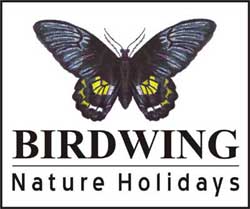
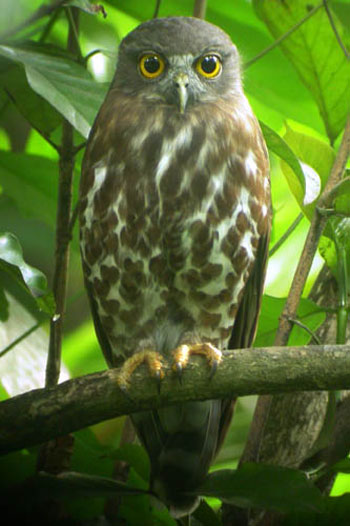
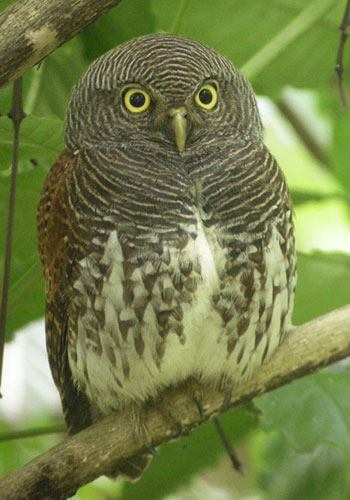
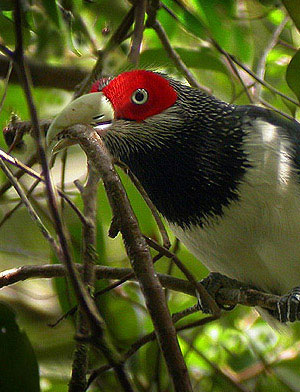
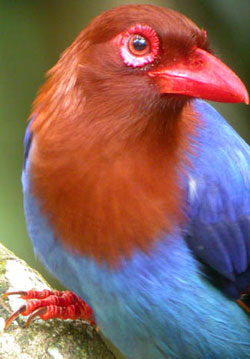
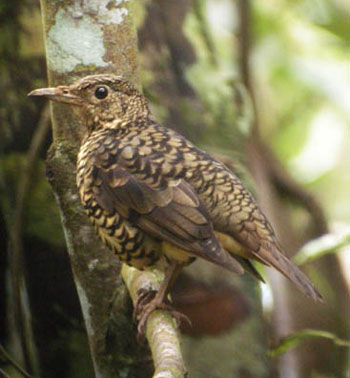
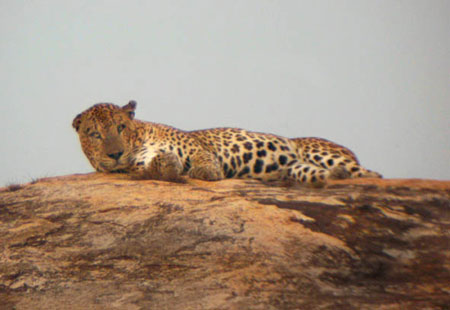
"Here is a sort of Bird they call Carlo, which never lighteth on the ground, but always sets on very high Trees. He is as big as a Swan, the colour black, the Legs very short, the Head monstrous, his Bill very long, a little rounding like a Hawks, and white on each side of the head, like ears: on the top of the crown growth our a white thing, somewhat like to the comb of a Cock…The bodies of the Fowls are good to eat" - Robert Knox, 1681
The classification and nomenclature adopted in this species list by me follows the Birds of South Asia The Ripley Guide (2005) by Pamela C. Rasmussen and John C. Anderton (the BSA, hereafter) except for where taxonomic changes taken place since its publication. These include treating Grey Tit Parus cinereus distinct from Great Tit Parus major complex as per Packert et al in 2005.
Where vernacular and scientific names have been subjected to change following taxonomic revisions suggested in the BSA, I have accepted and adopted those changes. Therefore I have used Eastern Cattle Egret Bubulcus coromandus for Cattle EgretBubulcus ibis. Where country name appears in bird names I have used Sri Lanka, which is the present geo-political name (formulated through Sri Lanka Republic Act 1972 –An Act passed in the British Parliament that saw our country name being renamed to Sri Lanka from Ceylon effective, 22nd May, 1972), which is also the country name followed in the widely accepted ‘An Annotated Checklist of the Birds of the Oriental Region’ by Inskipp et al in 1996 published by the Oriental Bird Club (the OBC checklist, hereafter). Therefore, I have retained the established vernacular; Sri Lanka Spurfowl in place of Ceylon Spurfowl as referred in the BSA.
Where a scientific name has been subjected to change in the BSA due to various valid reasons, which does not result in the elevation of a species to a new one, I have used the revised scientific name but again retained the established vernacular as per the OBC checklist. Thus I have adopted Eumyias sordidus for Eumyias sordida of the OBC checklist but retained Dull-blue Flycatcher as per the latter instead of ‘Dusky Blue Flycatcher’ referred in the BSA. In all other cases where vernacular names have been changed in the BSA, I have retained the already established names of the OBC checklist. Thus I have retained Black-shouldered Kite in place of Black-winged Kite.
For some of the splits, justifications for the treatment as separate species have appeared in scientifically valid publications and the rest are being done by avian taxonomists and it is likely that the number of endemics of Sri Lanka may go up in time to come as several more forms from Sri Lanka that were lumped as subspecies of allopathic polytypic species in the great lumping era of the early 20th century (embracing the biological species concept) go under the scrutiny of the splitters. It should be noted that most of these splits treated as endemic to Sri Lanka in the BSA were considered to be endemic to Sri Lanka when they were originally described in the 19th century - in the colonial era of natural history exploration before they were lumped subsequently in the early 20th century.
Coming back to this species list, the number of days each bird is observed is listed in parenthesis. Udawalawe refers to the general area not the National Park. Yala and Bundala refer to the National Park. Endemic bird names are shown in bold-faced text in addition to mentioning this in the comment that follows their names. Those birds that were ‘heard only’ are not mentioned in this list.
PODICIPEDIDAE
1. Little Grebe Tachybaptus ruficollis (4) Fair numbers. Easily over 100 in Nawadamkulama.
PHALACROCORACIDAE
2. Little Cormorant Phalacrocorax niger (11) The commonest Cormorant.
3. Indian Cormorant Phalacrocorax fuscicollis (4) Fair numbers in the dry zone.
4. Great Cormorant Phalacrocorax carbo (3) Scarce Resident seen in the dry zone.
ANHINGIDAE
5. Oriental Darter Anhinga melanogaster (4) Small numbers at Tissa, Bundala & Yala.
PELECANIDAE
6. Spot-billed Pelican Pelecanus philippensis (5) Good views at Bundala.
ARDEIDAE
7. Little Egret Egretta garzetta (11) Commonest Egret.
8. Great Egret Egretta alba (7) Encountered in reasonable numbers in the wet & dry zones.
9. Intermediate Egret Egretta intermedia (5) Fairly common.
10. Grey Heron Ardea cinerea (7) Encountered in reasonable numbers in the wet & dry zones.
11. Purple Heron Ardea purpurea (5) Fairly common.
12. Eastern Cattle Egret Bubulcus coromandus Common. Split from B.ibis.
13. Western Reef Egret Egretta gularis (1) A single white morph individual observed at Bundala.
14. Indian Pond-Heron Ardeola grayii (12) Common.
15. Little Heron (Striated H) Butorides striata (1) Only sighting was at Bundala.
16. Black-crowned Night-Heron Nycticorax nycticorax (1) Just one individual seen at Tissa.
17. Malayan Night Heron Goraschius melanolophus (1) One chance encounter at Sinharaja.
18. Yellow Bittern Ixobrychus sinensis (2) Seen well at Bundala NP & Deberawewa
19. Black Bittern Dupetor flavicollis (2) Good views of 3 birds at Deberawewa.
CICONIIDAE
20. Painted Stork Mycteria leucocephala (5) Seen in small numbers in the dry zone.
21. Asian Openbill Anastomus oscitans (9) Common.
THRESKIORNITHIDAE
22. Black-headed Ibis Threskiornis melanocephalus (6) All sightings in the dry zone.
23. Eurasian Spoonbill Platalea leucorodia (4) Seen at Tanamalwila, Tissa, Bundala & Yala
ANATIDAE
24. Lesser Whistling-Duck Dendrocygna javanica (5) Locally common in the dry zone wetlands.
25. Cotton Pygmy-goose Nettapus coromandelianus (2) Tanamalwila & Weerawila.
26. Northern Pintail Anas acuta (1) A flock of 35 flying overhead at Chilaw.
27. Garganey Anas querquedula (4) Fair numbers in Tanamalwila, Tissa & Bundala.
ACCIPITRIDAE
28. Oriental Honey-Buzzard Pernis ptilorhyncus (4) Seen well in flight and perched.
29. Black-shouldered Kite (B-winged K) Elanus caeruleus (3) Seen at Udawalawe & Yala.
30. Brahminy Kite Haliastur indus (7) Common.
31. White-bellied Sea-Eagle Haliaeetus leucogaster (6) Mostly above dry zone tanks/wetlands.
32. Grey-headed Fish-Eagle Ichthyophaga ichthyaetus (1) A distant perched bird at Yala.
33. Crested Serpent-Eagle Spilornis cheela (6) Endemic race: spilogaster was fairly frequent.
34. Crested Goshawk Accipiter trivagatus (2) A fly over at Kithulgala. Endemic race: layardi
35. Shikra Accipiter badius (3) Good views of the nominate race at Kithulgala.
36. Besra Accipiter virgatus (1) Excellent flight views of a pair at Sinharaja.
37. Himalayan Buzzard Buteo burmanicus (1) 2 perched views. Split from B.buteo.
38. Black Eagle Ictinaetus malayensis (4) Fine views at Kithulgala and Sinharaja.
39. Booted Eagle Hieraaetus pennatus (1) A dark morph bird observed from Martin’s in Sinharaja.
40. Rufous-bellied Eagle Hieraaetus kienerii (1) An immature seen in flight while on the way to Kithulgala. Smaller nominate race.
41. Crested Hawk-Eagle Spizaetus cirrhatus (3) The endemic race; ceylanensis was seen well at Bundala and Yala. An Indian Sub continent endemic.
42. Common Kestral Falco tinnuculus (3) Seen at Udawalawe and Tissa & Yala.
PHASIANIDAE
43. Sri Lanka Spurfowl Galloperdix bicalcarata (4). Endemic species. We had excellent views of this ultra-elusive endemic in Kithulgala and Sinharaja with a total of 8 birds seen between us.
44. Sri Lanka Junglefowl Gallus lafayetii (7) Endemic species. Quite habituated in Sinharaja,
45. Indian Peafowl Pavo cristatus (5) We saw this Indian subcontinent endemic at the dry zone.
TURNICIDAE
46. Barred Buttonquail Turnix suscitator (1) Endemic race: leggei seen only by Peter at Bundala.
RALLIDAE
47. Slaty-legged Crake Rallina eurizonoides (2) 1 seen well by myself alone one late afternoon at Victoria Park when rainy weather & other exigencies prompted the rest of the team to stay back. 1 bird seen by 2 participants on the following morning.
48. White-breasted Waterhen Amaurornis phoenicurus (9) Common.
49. Watercock Gallicrex cinerea (1) 4 sightings of female-type ones at Bundala.
50. Purple Swamphen (6) Porphyrio poliocephalus Common. A recent split from P.porphyrio.
51. Common Moorhen Gallinula chloropus (3) Seen at Bundala, Yala & Tissa
52. Common Coot-Fulica atra (1) Only sighting of this scarce resident was at Nawadamkulama proved to be our 252nd and the last new bird of the trip.
JACANIDAE
53. Pheasant-tailed Jacana Hydrophasianus chirurgus (6) Locally common. Many were sporting breeding regalia at Tanamalwila, Tissa, Bundala, Yala & Nawadamkulama.
ROSTRATULIDAE
54. Greater Painted-snipe Rostratuka benghalensis (1) A total of 7 birds comprising of 4 dull-looking males and 3 good-looking females of this scarce breeding resident presented excellent views at close quarters at Bundala.
HAEMATOPODIDAE
55. Eurasian Oystercatcher (1) Haematopus ostralegus A pair of this scarce migrant, which usually winter in north-western and northern Sri Lanka was seen at the Chilaw Sandspits.
CHARADRIIDAE
56. Pacific Golden Plover Pluvialis fulva (3) Good views at Bundala.
57. Grey Plover Pluvialis squatarola (2) Seen at Bundala & Palawi Saltpans.
58. Little Ringed Plover Charadrius dubius (4) Seen at Tanamalwila, Bundala, Yala & Chilaw
59. Kentish Plover Charadrius alexandrinus (4) Seen at Bundala, Yala, Chilaw & Kalpitiya.
60. Greater Sand Plover Charadrius leschenaultii (1) Only sighting at Bundala was quite good.
61. Lesser Sand Plover Charadrius mongolus (4) Seen at Tanamalwila, Bundala, Yala & Chilaw.
62. Yellow-wattled Lapwing Vanellus malabaricus (3) Good views at Udawalawe. A subcontinent endemic.
63. Red-wattled Lapwing Vanellus indicus (7) Common. The endemic race: lankae.
SCOLOPACIDAE
64. Pintail Snipe Gallinago stenura (1) Good views at Tanamalwila, Bundala & Yala.
65. Black-tailed Godwit Limosa limosa (4) Fairly large concentrations at Bundala.
66. Eurasian Whimbrel Numenius phaeopus (2) Seen at Chilaw & Kalpitiya.
67. Eurasian Curlew Numenius arquata (2) Two at Bundala & Kalpitiya.
68. Common Redshank Tringa totanus (2) Fair numbers at Bundala, Yala & Kalpitiya.
69. Common Greenshank Tringa nebularia (4) Fair numbers at Bundala, Yala & Kalpitiya.
70. Marsh Sandpiper Tringa stagnatilis (5) Seen at Tanamalwila, Bundala, Yala and Kalpitiya.
71. Green Sandpiper Tringa ochropus (1) A single bird at Bundala.
72. Wood Sandpiper Tringa glareola (6) Common.
73. Common Sandpiper Actitis hypoleucos (6) Common!
74. Ruddy Turnstone Arenaria interpres (2) Small numbers at Bundala & Yala.
75. Sanderling Calidris alba (1) Over 50 at the Chilaw Sandspits.
76. Little Stint Calidris minuta (5) Seen at Bundala, Yala, Chilaw & Kalpitiya.
77. Curlew Sandpiper Calidris ferruginea (2) Seen at Bundala and Kalpitiya.
78. Broad-billed Sandpiper Limicola falcinellus (1) Small numbers at Bundala.
79. Ruff Philomachus pugnax (2) Very small numbers at Tanamalwila and Bundala.
RECURVIROSTRIDAE
80. Black-winged Stilt Himantopus himantopus (4) Seen well at Tissa, Bundala & Yala. One ‘Australian-type’ individual with black hind neck was also seen.
PHALAROPODIDAE
81. Red-necked Phalarope Phalaropus lobatus (1) A solitary bird at Bundala offered good views.
BURHINIDAE
82. Indian Thick-knee Burhinus indicus (1) The only sightings were reported at Bundala. This is a split from Eurasian Stone-Curlew B. oedicnemus.
83. Great Thick-knee Esacus recurvirostris (4) Fair numbers at Bundala, Yala and at the beach at Kandakkuliya, which contained 8.
GLAREOLIDAE
84. Small Pratincole (Milky P) Glareola lactea (1) Exceptional views. Only sighting was at Bundala saltpans. Appeared to be nesting on the track judging by ‘broken-wing behaviour’.
LARIDAE
85. Brown-headed Gull Larus brunnicephalus (4) Good views at Bundala and Palawi Saltpans.
86. Heuglin’s Gull Larus heuglini (1) A Pair seen in flight in the sea in front of the Chilaw Resthouse was a good record for this Gull, which usually winters north-western/northern coastal zone in Sri Lanka.
STERNIDAE
87. Gull-billed Tern Gelochelidon nilotica (6) Common.
88. Caspian Tern Hydroprogne caspia (4) Seen well at Bundala & Palawi Saltpans.
89. Lesser Crested Tern Thalasseus bengalensis (2) Good views at Chilaw.
90. Great Crested Tern Thalasseus bergii (2) Seen at Bundala & Palawi Saltpans.
91. Common Tern Sterna hirundo (2) Seen well in Chilaw and Kalpitiya.
92. Little Tern Sternula albifrons (4) Small numbers at Tissa, Bundala, Chilaw & Kalpitiya.
93. Whiskered Tern Chlidonias hybrida (7) Common.
94. White-winged Tern Chlidonias leucopterus (7) Seen well at Yala & Bundala.
COLUMBIDAE
95. Rock Pigeon Columba livia (7) Common with wild populations in Tissa &Yala.
96. Sri Lanka Woodpigeon Columba torringtoni (1) Endemic species. Cracking views of a pair at eye-level at the Surrey Estate was the only sighting.
97. Spotted Dove Streptopelia chinensis (12) Common. The endemic race ceylonensis.
98. Emerald Dove Chalcophaps indica (3) Endemic race; robinsoni was seen well at Kithulgala.
99. Orange-breasted Green Pigeon Treron bicinctus (4) Endemic race; leggei seen well at Udawalawe and Bundala and Yala.
100. Sri Lanka Green-Pigeon Treron pompadora (6) Endemic species. Recent split. Formally ‘Pompadour Green-Pigeon’ T. pompadora, which is now being split into several different species. Seen well at Kithulgala, Sinharaja & close to Tissa.
101. Green Imperial-Pigeon Ducula aenea (9) Common.
PSITTACIDAE
102. Sri Lanka Hanging-Parrot Loriculus beryllinus (7) Endemic species. Rather common.
103. Alexandrine Parakeet Psittacula eupatria (6) Small numbers generally.
104. Rose-ringed Parakeet (Ring-necked P) Psittacula krameri (9) Common.
105. Layard’s Parakeet Psittacula calthropae (6) Endemic species. Great views at Kithulgala.
CUCULIDAE
106. Green-billed Coucal Centropus chlororhynchos (1) Endemic species. Missed out on the usually reliable site in Kithulgala but got cracking views of a pair at a nest site in the deep forest in Sinharaja, which I had found in late Jan, 2008
107. Southern Coucal Centropus sinensis (7) Common.
108. Sirkeer Malkoha Taccocua leschenaultii (1) Great views of a basking bird at Yala in one morning was the only view of this scarce resident. Endemic to the Indian subcontinent.
109. Red-faced Malkoha Phaenicophaeus pyrrhocephalus (1) Endemic species. A single bird was seen well in a bird flock in Sinharaja was the only sighting.
110. Blue-faced Malkoha Phaenicophaeus viridirostris (2) Seen in the hotel gardens of Safari Village, Udawalawe and again at Yala.
111. Chestnut-winged Crested Cuckoo Clamator coromandus (1). A calling bird at dawn at Sinharaja flew away revealing its silhouette.
112. Pied Cuckoo (Jacobin C) (1) Clamator jacobinus Seen well at Bundala
113. Asian Koel Eudynamys scolopaceus (2) Seen at Udawalawe and Katunayake.
114. Banded Bay Cuckoo Cacomantis sonneratii (1) After hearing a few on Day 1, obtained scope views of a perched bird at Kithulgala on Day 2.
115. Grey-bellied Cuckoo Cacomantis passerinus (1) Only sighting was at Bundala.
TYTONIDAE
116. Common Barn-Owl (Barn Owl) Tyto alba (2). The first encounter at Tissa at pre-dawn was seen only by me. A vigil on the following morning yielded excellent views when an adult bird visited a nest-hole, which contained nestlings judged from constant noises heard from it.
STRIGIDAE
117. Serendib Scops-Owl Otus thilohoffmanni (2) Endemic species. Discovered in 2001 and described in 2004. Exceptional views at Sinharaja after a heartbreaking initially encounter at Kithulgala seen only by me and another guide, but not our discerning visitors. One of the 2 Sri Lankan endemics in the IUCN Red List of Threatened species.
118. Indian Scops-Owl Otus bakkamoena (1) An excellent nighttime observation of a single at the hotel gardens in Udawalawe. Spilt from Collared Scops-Owl O. lempiji of South East Asia.
119. Brown Fish-Owl Bubo zeylonensis (1) A single bird in a day roost in Udawattekele Kandy. Endemic race: zeylonensis.
120. Brown Wood-Owl Strix leptogrammica (1) A pair seen at the traditional day roost at Surrey Tea Estate. Easily disturbed.
121. Chestnut-backed Owlet Glaucidium castanonotum (1) Endemic species. A pair at Kitulgala provided cracking views on Day 1.
122. Brown Hawk Owl (B Boobook) Ninox scutulata (1) A roosting pair in a well-wooded garden in close to the airport was our first tick of the tour. Race: hirsuta endemic to South-West India and Sri Lanka.
PODARGIDAE
123. Sri Lanka Frogmouth (Sri Lanka F) (2) Batrachostomus moniliger A single bird seen in flight at dusk was uncooperative, but a male in the following morning offered cracking views, low down. Endemic to South India and Sri Lanka.
CAPRIMULGIDAE
124. Indian Nightjar (I Jungle N) Caprimulgus asiaticus (1) A single bird observed well at dusk at Udawalawe. Endemic race: eidos.
APODIDAE
125. Indian Swiftlet Aerodramus unicolor (2) Seen at Kithulgala and Sinharaja. Endemic to SW India and Sri Lanka.
126. Brown-backed Needletail Hirundapus giganteus (2) Excellent views in Sinharaja.
127. Asian Palm-Swift Cypsiurus balasiensis (10) Common.
128. Little Swift Apus affinis: (9) Common.
HEMIPROCNIDAE
129. Crested Treeswift Hemiprocne coronata (5) Flight views seen at Kithulgala, Sinharaja, Udawalawe but the sighting at Yala NP topping up with a pair of these seen perched at close quarters.
TROGONIDAE
130. Malabar Trogon Harpactes fasciatus (2) Great views at Sinharaja. Endemic to southern India and Sri Lanka. Endemic nominate race.
ALCEDINIDAE
131. Common Kingfisher Alcedo atthis (6) Generally common.
132. Black-backed Dwarf Kingfisher Ceyx erithaca (1) Cracking views at Kithulgala.
133. Stork-billed Kingfisher Pelargopsis capensis (2) Seen at Kithulgala and Katunayake.
134. White-throated Kingfisher Halcyon smyrnensis (10) Common.
135. Pied Kingfisher (Lesser P K) Ceryle rudis (3) Seen well at Bundala and Yala.
MEROPIDAE
136. Green Bee-eater (Green B-e) Merops orientalis (5). A regular in the dry zone. Endemic race: ceylonicus.
137. Blue-tailed Bee-eater Merops philippinus (8) Common.
138. Chestnut-headed Bee-eater Merops leschenaulti (5) Seen well in Kithulgala.
CORACIIDAE
139. Indian Roller Coracias benghalensis (5) Seen regularly in the dry zone mostly in wayside.
UPUPIDAE
140. Common Hoopoe (Eurasian H) Upupa epops (3) Seen well in Bundala and Yala. Endemic race: ceylonensis
BUCEROTIDAE
141. Sri Lanka Grey Hornbill Ocyceros gingalensis (4) Endemic species. Seen well in Kithulgala and Sinharaja.
142. Malabar Pied Hornbill Anthracoceros coronatus (2) Great views at Yala. A subcontinent endemic.
CAPITONIDAE
143. Brown-headed Barbet Megalaima zeylanica (8) Common. An Indian subcontinent endemic. Endemic nominate race.
144. Yellow-fronted Barbet Megalaima flavifrons (7) Endemic species. Regularly sightings in the wet zone.
145. Sri Lanka Small Barbet (Crimson-fronted B) Megalaima rubricapillus (4) Endemic species. Good views at Kithulgala, Kudawa, Udawattekele & Kurunegala.
146. Coppersmith Barbet Megalaima haemacephala (3) Seen well at Udawalawe and Kurunegala.
PICIDAE
147. Indian Pygmy Woodpecker (Brown-capped PW) Picoides nanus (2) The endemic race; gymnophthalmus was seen well at Tanamalwila and Yala. An Indian subcontinent endemic.
148. Lesser Yellownape Picus chlorolophus (2) Endemic race; wellsi, seen at Sinharaja.
149. Black-rumped Flameback Dinopium benghalense (3) The endemic race: psarodes was encountered at Kithulgala, Sinharaja and Yala.
150. Crimson-backed Flameback Chrysocolaptes stricklandi (1) Endemic species. Spilt from Greater Flameback (C.lucidus). A pair seen well in Udawattekele, which saw a clean up act of the endemics. Heard from my room in the Amaya Hills Hotel in Kandy. Silent in other areas visited.
151. White-naped Woodpecker (W-n Flameback) Chrysocolaptes festivus (1) A prolonged view of a cracking male of the endemic race: tantus of this Indian sub continent endemic at a roadside tree at Tissa was pure luck. Sightings are uncommon at the traditional site at Deberawewa owing to disturbance.
PITTIDAE
152. Indian Pitta Pitta brachyura (4) Excellent views at Kithulgala and was a good filler at the Victoria Park while starting at the muck for S-l crake. Wintering Indian Subcontinent endemic.
ALAUDIDAE
153. Jerdon’s Bushlark Mirafra affinis (5) Seen well at Uda Walawe, Tissa, Bundala & Yala.
Split from M.assamica. An Indian sub continent endemic.
154. Oriental Skylark Alauda gulgula (2) Only seen at Bundala.
155. Ashy-crowned Finch-Lark (A-c Sparrow-Lark) Eremopterix grisea (2) Seen well at Udawalawe and Yala. An Indian subcontinent endemic.
HIRUNDINIDAE
156. Barn Swallow Hirundo rustica (7) Common.
157. Hill Swallow Hirundo domicola (2) Seen at Pattipola and inside the Glenloch tea factory. Split from Pacific Swallow H. tahitica. Endemic to south-west India and Sri Lanka.
158. Red-rumped Swallow Hirundo daurica Seen over Udawalawe reservoir.
159. Sri Lanka Swallow Hirundo hyperythra (3) Endemic species. Good views at Kithulgala. Split from Red-rumped Swallow (H.dauma)
MOTACILLIDAE
160. Forest Wagtail Dendronanthus indicus (5) Seen well at Tissa and Victoria Park.
161. Grey-headed Wagtail Motacilla [flava] thunbergi (1) Seen at Tanamalwila.
162. Grey Wagtail Motacilla cinerea (6) Seen at a few places including Victoria Park.
163. Paddyfield Pipit Anthus rufulus (8) common.
164. Blyth’s Pipit Anthus godlewskii (2) Seen well at Udawalawe.
CAMPEPHAGIDAE
165. Black-headed Cuckoo-shrike Coracina melanoptera (1) Good views at Yala.
166. Large Cuckoo-shrike Coracina macei (1) Seen close to Tissa. Endemic race: layardi.
169. Small Minivet Pericrocotus cinnamomeus (2) Seen at Yala and close to Tissa.
170. Orange Minivet Pericrocotus flammeus (6) Rather common in the wet zone. Considered distinct from Scarlet Minivet P. speciosus. A sub continent endemic.
171. Bar-winged Flycatcher-shrike (Pied F-s) Hemipus picatus (5) Good views at lowland wet and dry zones and highlands Endemic race leggei.
172. Sri Lanka Woodshrike Tephrodornis affinis (2) Endemic species. Good views at Tanamalwila and Yala. Split from Common Woodshrike T. pondicerianus.
MONARCHIDAE
173. Asian Paradise Flycatcher Terpsiphone paradisi (7) Good views of the migrant white morph as well as the red morph of the endemic race; ceylonensis with well-endowed tail streamers.
174. Black-naped Monarch Hypothymis azurea (3) Good views of the endemic race; ceylonensis at Kithulgala and Sinharaja.
RHIPIDURIDAE
175. White-browed Fantail Rhipidura aureola (5) Seen well at Kithulgala and dry zone.
PYCNONOTIDAE
176. Black-capped Bulbul (Black-crested B) Pycnonotus melanicterus (6) Endemic species. Good sightings in Kithulgala and Sinharaja.
177. Red-vented Bulbul Pycnonotus cafer (13) Ubiquitous. The endemic race: haemorrhousus.
178. Yellow-eared Bulbul Pycnonotus penicillatus (3) Endemic species. Cracking views of this good-looking montane endemic were had at the Victoria Park and Hakgala.
179. White-browed Bulbul Pycnonotus luteolus (5) A top teaser which kept eluding us every time we lifted our binocs for a good 4 days before our proper sighting at Yala. An Indian subcontinent endemic, and represented here by the endemic race; insulae.
180. Yellow-browed Bulbul Hypsipetes indica (3) Good views at Kithulgala and Sinharaja in bird waves. Endemic to southwest India and Sri Lanka.
181. Square-tailed Black Bulbul Hypsipetes ganeesa (7) Split from H. leucocephalus and now endemic to south-west India and Sri Lanka. Endemic race: humii offered good views at Sinharaja.
AEGITHINIDAE
182. Common Iora Aegithina tiphia (2) After only hearing at several locations seen at Lunugamwehera where it is sympatric with the species below. Race: multicolor endemic to South-West India and Sri Lanka.
183. Marshall’s Iora (White-tailed I) Aegithina nigrolutea (1) Cracking views of an agitated pair at Lunugamwehera. It showed prominent white tips on upper as well as lower tail, white on tail sides and broadly white edged tertials. A male observed had the above diagnostics and a black cap. The FOGSL found this population after they rediscovered a breeding population of this bird species at the Yala East (Kumana) National Park in the South East Sri Lanka in March, 2006 according to Kalutota (2006). This was following its addition to the Sri Lankan inventory of birds by Wells et al., 2003, based on a re-identified a specimen of this species (collected from Nilgala in the Uva avi-faunal zone in 1948 by Major W.W. A Phillips) lodged in BMNH, attributed as an aberrant A.tiphia. Thereafter The BSA announced this to wider audiences in 2005.
CHLOROPSEIDAE
184. Gold-fronted Leafbird (Golden-f L) Chloropsis aurifrons (3) Seen at Kithulgala and Sinharaja.
185. Jerdon’s Leafbird Chloropsis jerdoni (3) Scope views of one at Udawalawe the best of the sightings. Split from Blue-winged Leafbird C. cochinchinensis.
LANIIDAE
186. Brown Shrike Lanius cristatus (10) Common. Race: lucionensis not noted.
TURDIDAE
187. Pied Thrush (P Ground T) Zoothera wardii (1) After a bit of a runaround initially, a male descended lowdown on to offer good views. A Himalayan breeder almost exclusively wintering in Sri Lanka. An Indian subcontinent endemic.
188. Spot-winged Thrush Zoothera spiloptera (4) Endemic species. Great views in Kithulgala and Sinharaja.
189. Sri Lanka Scaly Thrush Zoothera imbricata (4) Endemic species. 3 sightings in Sinharaja including scope views and a single bird in Victoria Park at point blank range while trying for Pied Thrush, didn’t help its reputation as a tough cookie. Split from Scaly Thrush Z. dauma.
190. Indian Blackbird (Nilgiri B) (1) Turdus simillimus A pair was seen at Hakgala. Split from Eurasian Blackbird T.merula and is considered to be an endemic to the southern Indian subcontinent. Endemic race kinnisii is dark bluish-slate with reddish-orange bill and orbital skin is likely to be split within a split ‘in the fullness of time’.
191. Sri Lanka Whistling Thrush (1) Myophonus blighi (1) A male of this ultra secretive endemic appeared just 2 minutes before the ‘predicted time’ but it was mildly redeeming when it cooperated to appear in the predicted perch to give prolonged views at Hakgala. This used to be the sole endemic representative of the IUCN Red List’s ‘Endangered’ category from Sri Lanka before Serendib Scops Owl entered the scene.
MUSCICAPIDAE
192. Asian Brown Flycatcher Muscicapa dauurica (6) Good views were had of this common migrant in several sites with the best being near Martin’s at Sinharaja.
193. Brown-breasted Flycatcher (Layard’s F) Muscicapa muttui (5) This regular migrant was encountered in Kithulgala, Sinharaja and close to Tissa. Named after the Tamil Cook; Muttu of its discoverer; Edgar L. Layard (pers.com. Bo Beolens, the Fat birder-lead author of Whose Bird?)
194. Kashmir Flycatcher Ficedula subrubra (1) A cracking adult male of this high profile Indian sub continent endemic which almost exclusively winter in the Sri Lankan hills was had at Hakgala.
195. Dull-blue Flycatcher (Dusky-b F) Muscicapa sordidus (2) Endemic species. 7 birds seen at the Hakgala on our first day in the highlands.
196. Tickell’s Blue Flycatcher Muscicapa tickelliae (4) Good views of the endemic race; jerdoni was had at Kithulgala, Sinharaja and the Surrey Estate.
197 Grey-headed Canary-Flycatcher Culicicapa ceylonensis (2) Seen well at the Surrey Estate, Bomuru-ella Forest Reserve and Hakgala.
198. Indian Blue Robin Erithacus brunnea (1) Fine views of this Himalayan winter visitor was had when a striking male appeared within our scanning zone while looking for a certain Spurfowl. It was also another ‘filler’ at the S-l Crake site in Victoria Park.
199. Oriental Magpie-Robin Copsychus saularis (12) Common.
200. White-rumped Shama Copsychus malabaricus (2) The endemic race; leggei seen well close to Tissa.
201. Indian Robin Saxicoloides fulicatus (5) Common resident in the dry zone. The local race, leucoptera, along with of South Indian fulicata, has glossy blueblack upperparts, unlike the northern races, which are brown above. An Indian subcontinent endemic.
202. Pied Bushchat Saxicola caprata (2) Good view in an around Nuwara Eliya. Endemic race; atrata.
TIMALIIDAE
203. Ashy-headed Laughingthrush Garrulax cinereifrons (2) Endemic species. Great views of this only Laughingthrush of Sri Lanka was had at Sinharaja where they occur in bird waves.
204. Brown-capped Babbler Pellorneum fuscocapillus (3) Endemic species. A pair of these showed well at Kithulgala and again at Sinharaja.
205. Sri Lanka Scimitar Babbler Pomatorhinus melanurus (3) Endemic species. Cracking views at Kithulgala, Sinharaja and Hakgala.
206. Tawny-bellied Babbler Dumetia hyperythra (3) Good views were had of the white-throated endemic race; phillipsi at Udawalawe, Bundala and Yala. Endemic to Indian subcontinent.
207. Dark-fronted Babbler Rhopocichla atriceps (3). Good views of the endemic race nigrifrons were had at Kithulgala and Sinharaja. Endemic to southern India and Sri Lanka
208. Yellow-eyed Babbler Chrysomma sinense (2) Good views of the endemic race; nasale was had at Udawalawe and Yala.
209. Orange-billed Babbler Turdoides rufescens (5) Endemic species. Good views at Kithulgala and Sinharaja where it is nucleus species in the bird waves with a 92 % presence.
210. Yellow-billed Babbler Turdoides affinis (10) Common. An Indian sub continent endemic.
Endemic race taprobanus
CISTICOLIDAE
211. Zitting Cisticola Cisticola juncidis (4) All sightings in the dry zone of the race: cursitans.
212. Grey-breasted Prinia Prinia hodgsonii (3) Seen at Udawalawe & Tissa. Endemic race: leggei
213. Ashy Prinia Prinia socialis (3) The endemic race: brevicauda seen at Udawalawe, Tissa, and Pattipola. Endemic to Indian sub continent.
214. Jungle Prinia Prinia sylvatica (2) Endemic race valida was seen well at Udawalawe and Tissa. Endemic to Indian sub continent.
215. Plain Prinia Prinia inornata (2) The endemic race: insularis was seen at Udawalawe.
216. Common Tailorbird Orthotomus sutorius (4) The endemic nominate race seen in the lowlands and the darker-toned fernandornis of highlands seen well in Nuwara Eliya.
SYLVIIDAE
217. Sri Lanka Bush Warbler Elaphrornis palliseri (1) Endemic species. A single bird skulked inside a bush ahead of a trail in Hakgala to present eye-ball views without too much pain. Moved from the earlier genus Bradypterus to a monotypic genus as the BSA.
218. Blyth’s Reed-Warbler Acrocephalus dumetorum (2) Seen well in Udawalawe and Bundala.
219. Indian Reed-Warbler Acrocephalus brunnescens (2) Good views at Deberawewa and Bundala. Endemic race: meridionalis.
220. Bright-green Warbler Phylloscopus nitidus (3) Seen at Sinharaja, Tissa and Hakgala.
221. Large-billed Leaf-Warbler Phylloscopus magnirostris (2) Heard more often. Encountered in Sinharaja and Nuwara Eliya.
PARIDAE
222. Grey Tit Parus cinereus (3) Seen at the riverine forests in near Tanamalwila, Nuwara Eliya and Kandy. f
SITTIDAE
223. Velvet-fronted Nuthatch Sitta frontalis (1) Seen in bird wave in Hakgala.
DICAEIDAE
224. Legge’s Flowerpecker (White-throated F) Dicaeum vincens (3). Endemic species. Cracking views at Sinharaja.
225. Pale-billed Flowerpecker Dicaeum erythrorhynchos (9) Common. Endemic race: ceylonense.
226. Thick-billed Flowerpecker Dicaeum agile (1) The endemic race: zeylonicum was seen near Tissa.
NECTARINIIDAE
227. Purple-rumped Sunbird Leptocoma zeylonica (9) Common. Endemic nominate race. An Indian Sub continent endemic.
228. Purple Sunbird Cinnyris asiatica (5) All sightings in the dry zone.
229. Loten’s Sunbird (Long-billed S) Cinnyris lotenius (7) Longer billed endemic nominate race was reasonably common. Endemic to southern India and Sri Lanka.
ZOSTEROPIDAE
230. Sri Lanka White-eye Zosterops ceylonensis (4) Endemic species. Few joining flocks at Sinharaja. Locally common in Nuwara Eliya.
231. Oriental White-eye Zosterops palpebrosus (3) Seen well at Kithulgala, Udawalawe & at the Surrey Estate. Endemic race: egregia
ESTRILDIDAE
232 White-rumped Munia Lonchura striata (4) The nominate race seen well at Kithulgala.
233. Scaly-breasted Munia Lonchura punctulata (5) Frequently encountered on wayside fields.
234. Tricoloured Munia (Black-headed M) Lonchura malacca (2). Seen at Bundala and Yala.
Found only in southern half of India and Sri Lanka.
235. Black-throated Munia Lonchura kelaarti (1) Exceptional views of this potential split at the access road to Horton Plains.
PASSERIDAE
236. House Sparrow Passer domesticus (6) Common.
PLOCEIDAE
237. Baya Weaver Ploceus philippinus (2) Seen a few in a nest colony in Yala.
STURNIDAE
238. White-faced Starling Sturnia albofrontata (2) Endemic species. After several fly over views, finally got perched views at Sinharaja close to the entrance.
239. Brahminy Starling Temenuchus pagodarum (1) Only sighting of this migrant was at Yala. Endemic to South Asia.
240. Rosy Starling Sturnus roseus (1) Only sighting of this migrant was at Udawalawe.
241. Common Myna Acridotheres tristis (12) Common. The darker toned endemic race melanosternus, which also shows a larger yellow facial patch than other races.
242. Sri Lanka Myna Gracula ptilogenys (3) Endemic species. Excellent views at Sinharaja. Mostly flight views with one good perched view.
243. Lesser Hill-Myna (Southern H M) Gracula indica (3) Split from the larger Hill Myna G. religiosa. Seen well in Kithulgala and Udawattekele Forest Reserve, Kandy.
ORIOLIDAE
244. Black-hooded Oriole Oriolus xanthornus (11) Common. Endemic race: ceylonensis.
DICRURIDAE
245. White-bellied Drongo Dicrurus caerulescens (8) Common. 2 endemic races; leucopygialis (‘white-vented’) in the wet zone and insularis (‘white-bellied’) in the dry zone were seen well. An Indian subcontinent endemic.
246. Sri Lanka Crested Drongo Dicrurus lophorinus (4) Endemic species. Excellent views at Kithulgala and Sinharaja. A nucleus species of the bird flocks in Sinharaja with an 89 % presence. Split from D. paradiseus.
247. Greater Racket-tailed Drongo Dicrurus paradiseus (1) The endemic race; ceylonicus seen only by Peter at Yala.
248. Ashy Drongo Dicrurus leucophaeus An uncommon migrant seen at eye-level from the top of ‘Elephant Rock’ (Athugala) at Kurunegala. It was diagnosable with its long and deeply forked tail compared to White-bellied Drongo, grey wash in the belly and clear red-eye.
ARTAMIDAE
249. Ashy Woodswallow Artamus fuscus (2) Observed while on the move.
CORVIDAE
250. Sri Lanka Blue Magpie Urocissa ornata (4) Endemic species. Fine views at Sinharaja including 5 birds that visited Martin’s open -sided restaurant/viewing area at the crack of dawn. Before that seen feeding on a snake.
251. House Crow Corvus splendens (10) Common.
252. Indian Jungle Crow Corvus culminatus (9) Common. A recent spilt from Large-billed Crow C. macrorhynchos. Thus this is an Indian subcontinent endemic.
List of other fauna.
Mammals:
1. Asian Elephant Elephas maximus Around 6 at Udawalawe.
2. Leopard Panthera pardus kotiya 2 sightings at Yala including 1 prolonged sighting.
3. Sri Lanka Golden Pal-cat Paradoxurus zeylonensis Seen only by me at Kithulgala.
4. Grey Mongoose Herpestes edwardsii Seen at Yala.
5. Ruddy Mongoose Herpestes smithii Seen at Yala.
6. Black-naped Hare Lepus nigricollis Seen at Yala
7. Jackal Canis aureus: Seen at Yala.
8. Purple-faced Leaf Monkey Trachypithecus vetulus including ‘Bear Money’ at Hakgala.
9. Toque Macaque Macaca sinica Endemic species. Seen frequently. Endemic:
10. Grey Langur Semnopithecus priam Seen frequently in the dry zone.
11. Layard’s Squirrel Funambulus layardi Seen regularly in mixed species bird flocks.
12. Giant Squirrel Ratufa macroura Seen at Sinharaja, Tissa and Yala.
13. Palm Squirrel Funambulus palmarum Common.
14. Giant Fruit Bat Pteropus giganteus Large roost in Kandy and several in other sites.
15. Yellow-striped Chevrotain Moschiola kathygre Endemic (recent split!) Expertly spotted by Graham J in association with a Mixed-species bird flock in Sinharaja. This is known to follow birds in the mixed species bird flocks in Sinharaja according to the FOGSL. Extremely wary and sightings during daytime are very rare.
16. Wild Boar Sus scrofa Seen at Yala.
17. Spotted Deer Axis axis Common at Yala.
18. Sambur Cervus unicolor Seen at Yala
19. Wild Buffalo Bubalus arnee Seen at Bundala and Yala
20. Wild Ass Equus asinus Locally common at Kandakkuliya, Kalpitiya.
Butterflies: These were some of the inevitable distractions.
1. Common Birdwing Troides darsius Cracking views at Sinharaja.
2. Crimson Rose Pachiliopta hector Seen at Udawalawe.
3. Common Rose Pachiliopta aristolochiae – Seen at Udawalawe.
4. Lime Butterfly Papilio demoleus Seen well at Udawalawe and Tissa
5. Common Mormon Papilio polytes – Seen at Sinharaja.
6. Blue Mormon Papilio polmnestor Very hard to ignore in Sinharaja.
7. Common Bluebottle Graphium agamemnon Seen at Sinharaja.
8. Tailed Jay Graphium agamemnon Seen at Sinharaja.
9. Common Jazebel Delias eucharis Seen at Tissa.
10. Three-spot Grass Yellow Eurema blanda Seen at Sinharaja.
11. Tree Nymph Idea iasonia Inevitable at Sinharaja.
12. Plain Tiger Danaus chrysippus Seen at Udawalawe
13. Common Crow Euploea core – Seen at most places
14. Great Crow Euploea phaenareta Seen well at Sinharaja.
15. Chocolate Soldier Junonia iphita Seen at the Elephant Rock, Kurunegala.
16. Common Sailor Neptis hylas Seen at Sinharaja.
17. Tawny Coster Acraea violae Seen at Udawalawe.
18. Red Pierrot – Seen at Udawalawe.
Reptiles:
1. Marsh Crocodile (Mugger) Crocodylus paluster: Seen at Bundala and Yala.
2. Land Monitor Varanus bengalensis: Frequently encountered in the dry zone.
3. Water Monitor Varanus salvator: Seen frequently in wetland sites.
4. Green Garden Lizard Calotes calote: Seen at Sinharaja.
5. Black-lipped Lizard Calotes nigrilabris: Endemic. Seen at Nuwara Eliya
6. Rhino-horned Lizard Ceratophora stoddartii: Endemic. One cracking individual at Hakgala.
7. Sri Lanka Kangaroo Lizard Otocryptis wiegmanni: Endemic. Seen at Kithulgala and Sinharaja
8. Star Tortoise Geochelone elegans: One encountered at Tanamalwila it was crossing the road.
10. Flapshell Turtle Lissemys punctata: Seen at several dry zone wetlands.
11. Common Bronzeback Tree Snake Dendrelaphis tristis: Seen thanks to a SL Blue Magpie.
Acknowledgements.
A big thank you for Peter Nickless for arranging this birding holiday and for his leadership. A guide cannot find over 250 birds on a 15 day Sri Lankan birding tour single-handedly and I wish to express my gratitude for everybody for chipping in to make this holiday a success. And for declaring 4th of Feb a Public holiday! Our driver; Sam (Sampath Jayasakara) did a terrific job in driving us safely and keeping our vehicle clean despite us reversing that at a regular basis. Sitting at the front seat, Roger Dodds who had been on guided birding trips from late Paleocene didn’t even bother to wear seat belts at times, which speaks volumes of how confident he felt with Sam behind the wheels. I wish he’d have equally good drivers in his next two birding trips to Antarctica and Bhutan this year! I owe my gratitude for the staff in the accommodations used for their efficient service and being flexible to accommodate our unique needs. Special thanks must go to Jaya & his clients; Ruth and Brad for their company and for sharing their hits & misses generously. A big thank you to all the local informants, site guides and jeep drivers for their local knowledge and assistance in the field. Finally, I wish to thank for the Receptionist at the Amaya Hills for his ‘creative manoeuverability’ (thanks, Sir Humphrey Appleby); I will continue to use your hotel for my clients!
References:
BirdLife International (2001) Threatened birds of Asia. Cambridge, UK: BirdLife International.
BirdLife International (2007) Species factsheet: Zoothera imbricata. Downloaded from http://www.birdlife.org on 7/3/2008
Bridge, E.S., Jones, A.W. and Baker, A.J. (2005) A phylogenetic framework for the terns (Sternini) inferred from mtDNA sequences: implications for taxonomy and plumage evolution. Molecular Phylogenetics and Evolution 35: 459-469.
Collar, N.J. (2004) Species limits in some Indonesian Thrushes. Forktail 20: 71–87.
Collar (2005) Family Turdidae (Thrushes). Pp. 514-910 in del Hoyo, J., Elliot, A. & Christie, D.A. eds. (2005) Handbook of the birds of the World. Vol. 10. Barcelona, Spain: Lynx Edicions.
Collar, N.J. (2006) A partial revision of the Asian Babblers (Timaliidae) Forktail 22: 85–112.
d’ Abrera, B.L. (1998) The Butterflies of Ceylon. Colombo, Sri Lanka: WHT Publications.
Darwin, C. (1871) The Descent of Man and Selection in relation to sex. John Murray, London.
Das, I. and De Silva, A. (2005) A Photographic Guide to the Snakes and other reptiles of Sri Lanka. London, UK: New Holland.
FOGSL. (2007) Sinharaja Rain Forest – Bird Life. Colombo, Sri Lanka FOGSL.
Groves, C.P. and Meijaard, E. (2005) Interspecific Variation in Moschiola, The Indian Chevrotain. The Raffles Bulletin of Zoology Supplement No.12: 413-421. Singapore: NUS.
Gunawardena, N. (2007) The Color of Serendipity - A Journey through Sri Lanka. Minnesota, U.S.A.: Traces of Eden Foundation.
Henry, G.M. (1998) A Guide to the birds of Ceylon. Third edition. Kandy, Sri Lanka and New Delhi, India: KVG de Silva & Sons and Oxford University Press.
Inskipp, T., Lindsey, N. and Duckworth, W. (1996) An Annotated Checklist of the Birds of the Oriental Region. Bedfordshire, UK: Oriental Bird Club.
Kalutota, C.D. (2006) Discovery of (a) new resident bird species from Sri Lanka. Siyoth, Journal of the Field Ornithology Group of Sri Lanka. Vol.1 (1): 47-49. Colombo, Sri Lanka: FOGSL.
Knox, R. (1681) An Historical Relation of the Island of Ceylon in the East Indies. Richard Chiswell, London. Reprinted in 2003, New Delhi: Navrang.
Kotagama, S.W. (2000) Endemic Birds of Sri Lanka. Colombo, Sri Lanka: WHT Publications.
Kotagama, S. W. and Goodale, E. (2004) The composition and spatial organization of mixed species flocks in a Sri Lankan rainforest. Forktail 20: 63–70.
Kotagama, S.W. (2004) Pictorial Pocket Guide -3 Mammals in Sri Lanka. Colombo, Sri Lanka: FOGSL.
Legge, W.V (1880) A History of the Birds of Ceylon. 2nd Edition. (4 vols in 1983). Dehiwala, Sri Lanka: Tisara Publishers.
Päckert, M., Martens, J., Eck, S., Nazarenko, A.A., Valchuk, O.P., Petri, B. and Veith, M. (2005) The Great tit (Parus major) – a misclassified ring species. Biological Journal of the Linnean Society, Volume 86, Number 2, October 2005, pp. 153-174 (22).
Rasmussen, P.C. and Anderton, J.C. (2005) Birds of South Asia. The Ripley guide. 2 Vols. Washington, D.C, U.S.A. and Barlelona, Spain: Smithsonian Institute and Lynx Edicions.
Salgado, A. (2007) Some observations on the Brown Hawk Owl (Ninox scutulata hirsuta). Siyoth, Journal of the Field Ornithology Group of Sri Lanka. Vol.2 (1): 47-48. Colombo, Sri Lanka: FOGSL.
Warakagoda, D. and Rasmussen, P.C. (2004) A New species of scops-owl from Sri Lanka. Bulletin of the British Ornithologists’ Club, 124 (2): 85-105. Norwich, UK.
Wells, D.R., Dickinson, E.C. and Dekker, R.W.R.J. (2003) Systematic notes on Asian birds. 34. A preliminary review of the Aegithinidae. Zooloische Verhandelingen. Leiden, Netherlands 344: 7-15. Wijesinghe, D.P. (1994) Checklist of the Birds of Sri Lanka. Special Pub. No. 2, Ceylon Bird Club. Colombo, Sri Lanka: CBC
Wijesinghe, D.P. (1997) Bird study in Sri Lanka: a historical perspective. OBC Bullettin, 26:26-31.
Photos © Amila Salgado. All Rights Reserved.
Contact Details: Amila Salgado, Birdwing Nature Holidays, 146 A, Pahala Bomiriya, Kaduwela, Sri Lanka
E-mail: amila@birdwingnature.com Website: www.birdwingnature.com Blog: http://gallicissa.blogspot.com